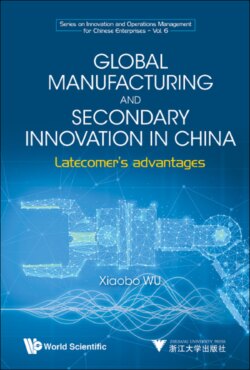Читать книгу Global Manufacturing and Secondary Innovation in China - Xiaobo Wu - Страница 15
На сайте Литреса книга снята с продажи.
1.2.2 Outbound investment quickly rising and net capital output achieved
ОглавлениеWith the deepening of globalization, Chinese manufacturing firms not only passively accept overseas investment, but also actively make outbound investment. And the trend of this two-way interactive investment is increasingly evident. Outbound direct investment is of great significance for Chinese companies to participate in international competition and cooperation. It can better leverage the resources and markets at home and abroad, and promote the sustained, rapid and healthy development of open economy.
Currently, with a continual increase of national strength, China is accelerating the implementation of the Belt ard Road Initiative and international cooperation on production capacity, and continuously perfecting its outbound investment policy system. Jointly powered by these and other factors, China’s outbound foreign investment has entered into the fast development track. In 2015, China’s outbound foreign direct investment hit a record high of USD 145.67 billion, up by 18.3% year-on-year, higher than the global growth rate.
Since China’s authorities released the yearly data in 2003 for the first time, China’s outbound foreign direct investment had been growing for 13 consecutive years (as shown in Diagram 1-5). The outbound investment in 2015 was 54 times of that in 2002. From 2002 to 2015, it grew at a yearly rate of 35.9%. At the same time, China’s outbound foreign direct investment (ODI) amounted to USD 145.67 billion in 2015, surpassing the amount of the FDI of the same year by USD 10.07 billion, achieving net capital output under the direct investment account for the first time (as shown in Diagram 1-6).
Diagram 1-5 China’s outbound foreign direct investment, 2002–2015
Data Source: 2015 Statistical Bulletin of China’s Outward Foreign Direct Investment issued by the Ministry of Commerce, National Bureau of Statistics and State Administration of Foreign Exchange.
Diagram 1-6 China’s actually utilized foreign capital and outward foreign direct investment, 2009–2015
Data Source: 2015 Statistical Bulletin of China’s Outward Foreign Direct Investment issued by the Ministry of Commerce, National Bureau of Statistics and State Administration of Foreign Exchange.
In the specific case of manufacturing industry, the outbound foreign investment of China’s manufacturing industry has generally maintained a rapid growth. The net annual ODI climbed from USD 620 million in 2003 to USD 19.99 billion in 2015, with an average annual growth rate of 34%. Diagram 1-7 exhibits the moderate growth of ODI in manufacturing industry between 2003 and 2009. However, between 2009 and 2012, in the post-financial-crisis era and before the outbreak of European debt crisis, the growth of ODI was marked by an apparent acceleration. After a short-term decline in 2013, it bounced back with a two-year’s sustained growth and even experienced a super-fast growth in 2015.
Diagram 1-7 Outbound foreign direct investment of China’s manufacturing industry
Data Source: 2015 Statistical Bulletin of China’s Outward Foreign Direct Investment issued by the Ministry of Commerce, National Bureau of Statistics and State Administration of Foreign Exchange.
Since the Reform and Opening-up, Chinese manufacturing firms have gone global and made recognized achievements in their cross-border operations. In general, the outbound foreign investment made by China’s manufacturing industry has the following characteristics:
(1) Continuously expanding investment coverage. With the continuous advancing of the Belt and Road Initiative, the outbound foreign investment of China’s manufacturing industry has an increasingly growing market, now expanding to six continents including Asia, Europe, Africa, North America, South America and Oceania.
(2) Relatively fast-growing total investment. The total investment increased by 31 times from USD 620 million in 2003 to USD 19.99 billion in 2015.
(3) The emergence of many large conglomerates with the capabilities for overseas investment, cross-border production, and R&D and sales, including Huawei Technologies Co., Ltd. and Zhejiang Geely Holding Group Co., Ltd., etc. These companies have grown into large comprehensive companies engaged in cross-regional and cross-border operations.
(4) Its proportion in China’s total outbound foreign investment remaining comparatively low. The ODI of China’s manufacturing industry is far lower than that of the service industry and its proportion in the total ODI is declining, also lower than that of Japan, the US and Germany (see Table 1-2).
There are still many problems with the outbound investment of China’s manufacturing industry, i.e, the shortage of cross-border management talent and lack of limited technology superiority.
Table 1-2 Outbound direct investments by China’s manufacturing industry
| Year | ODI by China’s manufacturing industry (unit: USD 100 million) | As a percentage of total ODI (%) |
| 2003 | 6.2 | 21.8 |
| 2004 | 7.6 | 13.7 |
| 2005 | 22.8 | 18.6 |
| 2006 | 9.1 | 4.3 |
| 2007 | 21.3 | 8.0 |
| 2008 | 17.7 | 3.2 |
| 2009 | 22.4 | 4.0 |
| 2010 | 46.6 | 6.8 |
| 2011 | 70.4 | 9.4 |
| 2012 | 86.7 | 9.9 |
| 2013 | 72.0 | 6.7 |
| 2014 | 95.8 | 7.8 |
| 2015 | 199.9 | 13.7 |
Data Source: Statistical Bulletin of China’s Outward Foreign Direct Investment issued by the Ministry of Commerce, National Bureau of Statistics and State Administration of Foreign Exchange in 2003–2015.
